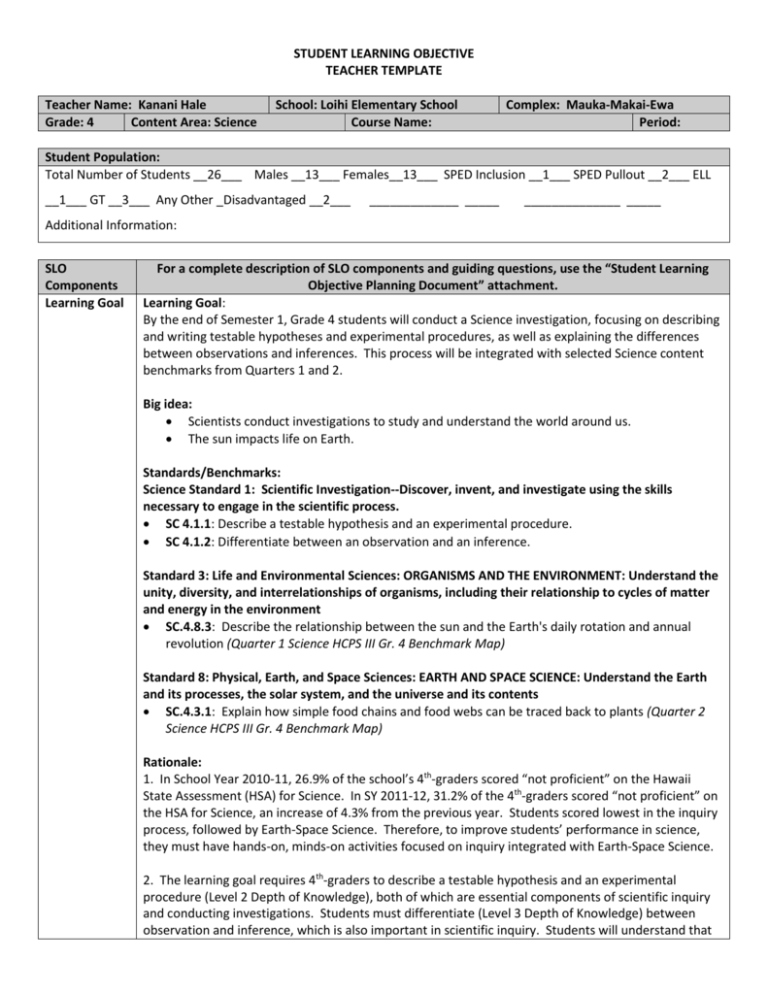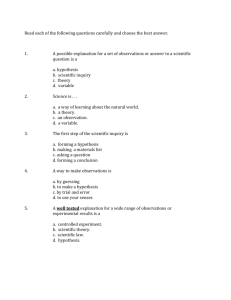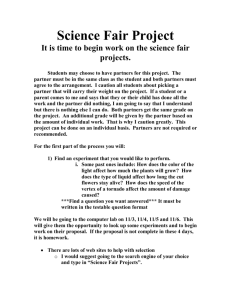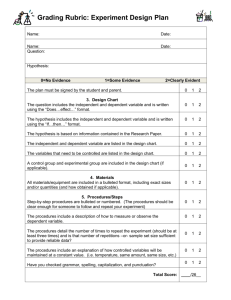Hawaii DOE student learning objectives
advertisement

STUDENT LEARNING OBJECTIVE TEACHER TEMPLATE Teacher Name: Kanani Hale Grade: 4 Content Area: Science School: Loihi Elementary School Course Name: Complex: Mauka-Makai-Ewa Period: Student Population: Total Number of Students __26___ Males __13___ Females__13___ SPED Inclusion __1___ SPED Pullout __2___ ELL __1___ GT __3___ Any Other _Disadvantaged __2___ _____________ _____ ______________ _____ Additional Information: SLO Components Learning Goal For a complete description of SLO components and guiding questions, use the “Student Learning Objective Planning Document” attachment. Learning Goal: By the end of Semester 1, Grade 4 students will conduct a Science investigation, focusing on describing and writing testable hypotheses and experimental procedures, as well as explaining the differences between observations and inferences. This process will be integrated with selected Science content benchmarks from Quarters 1 and 2. Big idea: Scientists conduct investigations to study and understand the world around us. The sun impacts life on Earth. Standards/Benchmarks: Science Standard 1: Scientific Investigation--Discover, invent, and investigate using the skills necessary to engage in the scientific process. SC 4.1.1: Describe a testable hypothesis and an experimental procedure. SC 4.1.2: Differentiate between an observation and an inference. Standard 3: Life and Environmental Sciences: ORGANISMS AND THE ENVIRONMENT: Understand the unity, diversity, and interrelationships of organisms, including their relationship to cycles of matter and energy in the environment SC.4.8.3: Describe the relationship between the sun and the Earth's daily rotation and annual revolution (Quarter 1 Science HCPS III Gr. 4 Benchmark Map) Standard 8: Physical, Earth, and Space Sciences: EARTH AND SPACE SCIENCE: Understand the Earth and its processes, the solar system, and the universe and its contents SC.4.3.1: Explain how simple food chains and food webs can be traced back to plants (Quarter 2 Science HCPS III Gr. 4 Benchmark Map) Rationale: 1. In School Year 2010-11, 26.9% of the school’s 4th-graders scored “not proficient” on the Hawaii State Assessment (HSA) for Science. In SY 2011-12, 31.2% of the 4th-graders scored “not proficient” on the HSA for Science, an increase of 4.3% from the previous year. Students scored lowest in the inquiry process, followed by Earth-Space Science. Therefore, to improve students’ performance in science, they must have hands-on, minds-on activities focused on inquiry integrated with Earth-Space Science. 2. The learning goal requires 4th-graders to describe a testable hypothesis and an experimental procedure (Level 2 Depth of Knowledge), both of which are essential components of scientific inquiry and conducting investigations. Students must differentiate (Level 3 Depth of Knowledge) between observation and inference, which is also important in scientific inquiry. Students will understand that hypotheses and experimental procedures are essential components of the scientific investigations. Students will use this process to explore and understand the basic ideas of the flow of energy, interdependence, and the relationship between the Sun and Earth in the Solar System. Interval of instruction necessary to address goal: ___ yearlong Assessments, Scoring and Criteria __X_ semester Planned assessments and criteria used to determine levels of performance: Assessments: Teachers from the Gr. 4 Data Team will select questions related to targeted benchmarks from the Riverside Formative Science Items to create a pre-/post-test to assess student progress. Teachers will also include constructed-response items to determine student understanding of the specific criteria identified below, such as “describe a testable hypothesis” and “give an example”. “Observe Then Infer” lesson: http://ims.ode.state.oh.us/ODE/IMS/Lessons/Content/CSC_LP_S05_BB_L06_I03_01.pdf The pre-assessment from this lesson will be used to gather baseline data on students’ understanding of the difference between observations and inferences. After the lesson, students will be assessed with the post-assessment and rubric in the lesson. During each quarter, students will use scientific investigation skills to explore science content benchmarks listed above on a weekly basis. Using the Elementary Inquiry Rubric (attached), students will self-review their investigation reports share their reports for peer review, and make necessary revisions. Then, they will submit their inquiry investigation reports to the teacher for feedback on their understanding of the inquiry process and the science concepts learned. Scoring: At the beginning of each quarter in the second semester, students will take the pre-test (developed by the Gr. 4 Data Team) focused on scientific inquiry integrated with the targeted science concepts. At the end of each quarter, students will take a post-test, then compare scores to reflect on their progress. Gr. 4 Data Team teachers will create a rubric to determine levels of proficiency for the pre/post-test and monitor student progress towards meeting/exceeding targeted HCPS III Gr. 4 Science benchmarks. The pre- and post-assessments from the “Observe Then Infer” lesson will be scored using the rubric in the lesson (see link for more detail: http://ims.ode.state.oh.us/ODE/IMS/Lessons/Content/CSC_LP_S05_BB_L06_I03_01.pdf) Students will engage in at least one inquiry investigation each quarter during the semester to explore and learn the science concepts listed above (SC.4.8.3, SC.4.3.1). At the end of each investigation, students will write an investigation report, do self-review, engage in peer review/feedback, and submit their report to the teacher to demonstrate their understanding of inquiry and science concepts. Reports will be scored using the Gr. 4 Inquiry Investigation Rubric. Assessment Criteria: (HCPS III benchmarks as “I can” statements): I can describe a testable hypotheses and an experimental procedure for an investigation I can explain the differences between an observation and an inference, and give an example of each. I can describe how the sun impacts life on earth Strand The Scientific Process Standard 1: The Scientific Process: SCIENTIFIC INVESTIGATION: Discover, invent, and investigate using the skills necessary to engage in the scientific process Topic Scientific Inquiry Benchmark SC.4.1.1 Describe a testable hypothesis and an experimental procedure Sample Performance Assessment (SPA) The student: Describes a testable hypothesis (e.g., if, then, because statement) and an experimental procedure to test it. Rubric Advanced Proficient Partially Proficient Novice Create a testable hypothesis and an experimental procedure to test it Describe a testable hypothesis and an experimental procedure Identify, with assistance, a testable hypothesis and an experimental procedure Recognize, with assistance, a testable hypothesis or an experimental procedure Topic Scientific Knowledge Benchmark SC.4.1.2 Differentiate between an observation and an inference Sample Performance Assessment (SPA) The student: Observes an object or situation and makes an inference from the observation, describing how they differ Rubric Advanced Proficient Partially Proficient Novice Explain the difference Differentiate between between an observation an observation and an and an inference and inference give examples Provide examples of observations and inferences Define an observation and an inference Strand Life and Environmental Sciences Standard 3: Life and Environmental Sciences: ORGANISMS AND THE ENVIRONMENT: Understand the unity, diversity, and interrelationships of organisms, including their relationship to cycles of matter and energy in the environment Topic Cycles of Matter and Energy Benchmark SC.4.3.1 Explain how simple food chains and food webs can be traced back to plants Sample Performance Assessment (SPA) The student: Diagrams and explains a simple food chain or food web that begins with plants. Rubric Advanced Proficient Partially Proficient Novice Compare the characteristics of simple food chains with those of food webs Explain how both simple food chains and food webs can be traced back to plants Describe how simple food chains or food webs can be traced back to plants Recognize that simple food chains or food webs can be traced back to plants Strand Physical, Earth, and Space Sciences Standard 8: Physical, Earth, and Space Sciences: EARTH AND SPACE SCIENCE: Understand the Earth and its processes, the solar system, and the universe and its contents Topic Earth in the Solar System Benchmark SC.4.8.3 Describe the relationship between the sun and the Earth's daily rotation and annual revolution Sample Performance Assessment (SPA) The student: Describes the position of the Earth in relation to the sun during the Earth's rotation and its annual revolution. Rubric Expected Targets Advanced Proficient Partially Proficient Use evidence to explain the relationship between the sun and the Earth's daily rotation and annual revolution Describe the Identify the Earth's relationship between daily rotation and the sun and the Earth's annual revolution daily rotation and annual revolution Novice Recognize that the Earth rotates daily and revolves annually around the sun Starting point for student performance groups: 1) Formative Pre-/Post-Assessment created by Gr. 4 Data Team (HCPS III Science Gr. 4 Benchmarks) were used by Gr. 4 Data Team to determine proficiency levels. 2) Student self-reflection and teacher feedback on investigation reports using Gr. 4 Inquiry Investigation Rubric 3) Pre-Assessment data from “Observe Then Infer” lesson (rubric in lesson will be used to place students into proficiency groups) Expected target for each student performance group: At the beginning of the school year, proficiency levels for grade 4 were established by the Gr. 4 Data Team. Below is a table showing the results for students in my class after taking the pre-assessment. Number of Students 2 6 13 5 Proficiency Level (Formative Pre/PostAssessment) 4 More than adequate progress (exceeding the standards—90% or higher on assessment) 3 Adequate progress (meeting the standards—70-89% on assessment) 2 Limited progress (approaching the standards—50-69% on assessment) 1 No progress (well below the standards— below 50% on assessment) At the end of the semester, all of my students will improve at least one proficiency level on the pre/post-Science Formative Assessment. Students who exceed the standards will be asked to apply their knowledge to develop an idea for a Science Fair Project. Near the end of each quarter, the Gr. 4 Inquiry Investigation Rubric will be used to assess student understanding of conducting a Science investigation, with a focus on making a hypothesis and experimental design in Semester 1. All of the 4th-grade students in my class, scoring in levels 1-3 in the “Hypothesis” and “Experimental Design” sections of the Elementary Inquiry Rubric at the beginning of the semester, will increase at least one level by the end of the semester. Those students who are already proficient in “Hypothesis” and “Experimental Design” will strive for proficiency (or higher) in the “Data”, “Data Analysis”, and “Discussion/Conclusion” sections of the rubric. Rationale for expected targets: After conducting inquiry-based Science investigations each quarter, Instructional Strategies students will have a better understanding of how to describe and write testable hypotheses and experimental procedures. Students will also be able to explain the differences between observations and inferences as they practice this skill during investigations. By incorporating Gr. 4 Science content benchmarks into inquiry-based investigations, students will gain a better understanding of both process and content in Science. Instructional strategies for each level of performance (all students): Pre-assessment: Use KWL, Riverside Formative Assessment items, and/or short constructed responses of inquiry and selected concepts to assess students’ understanding. 5-E Learning Cycle: Engage, Explore, Explain, Elaborate, and Evaluate to involve students in collaborative, hands-on, minds-on science inquiry experiences that integrate process with content. Students should experience at least one inquiry investigation each quarter. Use of cues, questions, and advanced organizers in presentations by teacher and students. Formative assessment: Use reflection, peer review/feedback, class discussion, to monitor progress toward learning goal. Generating and testing hypotheses in inquiry investigations--Engage students in a variety of structured tasks that include processes such as problem solving, experimental inquiry, and investigation. Along with written work, ask students to explain their hypotheses and their conclusions. Students not reaching proficient levels will be re-taught materials in smaller groups with individualized attention during class time (and before/after school, if needed). Students will also have the opportunity to use computer-based learning programs and kinesthetic/auditory/visual aids to re-learn class materials. Students will be given the opportunity to show what they have learned with alternative assessments such as videos, cartoons, dance, and songs (or other methods discussed and agreed upon by student and teacher). Resources for creating a Science SLO can be found at: http://www.livebinders.com/play/play/931189 To assess the Student Learning Objective, use the “Rubric for Rating the Quality of Student Learning Objectives” attachment Results SLO Rating Scale Teacher should attach the class record for students assessed. Teacher should also have available accompanying student assessments and scored rubrics. Rating rubric for teachers with a class of 5 or more students. ☐ Highly Effective ☐ Effective At least 90-100% of students met or exceeded expected target. At least 75-89% of students met or exceeded expected target. ☐ Developing ☐ Ineffective At least 60-74% of students met or exceeded expected target. Fewer than 60% of students met or exceeded expected target. Rating rubric for teachers with a class of 4 or less students. ☐ Highly Effective ☐ Effective Based on individual growth outcomes, all students met expected targets and some exceeded the targets. Based on individual growth outcomes, all students met expected targets. ☐ Developing ☐ Ineffective Based on individual growth outcomes, some students met or exceeded expected targets. Based on individual growth outcomes, no students met expected targets.








